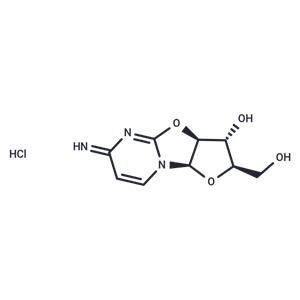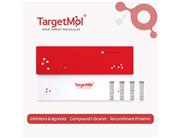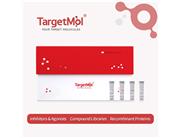| Name | Ancitabine hydrochloride |
| Description | Ancitabine hydrochloride (NSC 145668 HCl) is the hydrochloride salt of a cytarabine congener prodrug with antineoplastic activity. Upon administration, ancitabine is slowly hydrolyzed into cytarabine. Subsequently, cytarabine is converted to the triphosphate form within the cell and then competes with cytidine for incorporation into DNA. Because the arabinose sugar sterically hinders the rotation of the molecule within DNA, DNA replication ceases, specifically during the S phase of the cell cycle. Cytarabine agent also inhibits DNA polymerase, resulting in a decrease in DNA replication and repair. Compared to cytarabine, a more prolonged, consistent cytarabine-mediated therapeutic effect may be achieved with ancitabine because of the slow hydrolytic conversion of ancitabine to cytarabine. |
| Kinase Assay | Human placental aromatase activity: The assay is performed in a total volume of 1 mL at 37 ℃. Unless otherwise noted, the incubation mixture contains 11 nM [4- 14C] androstene-3, 17-dione ([4- 14C]A), 24 mM NADPH (tetrasodium salt Type III), the appropriate concentrations of the desired inhibitor, and 120 μg of microsomal protein. The (4- 14C)A is added as a solution in 1.7% ethanol in 0.05 M potassium phosphate buffer (pH 7.4), so that the final concentration of ethanol does not exceed 0.02% (v/v). The reaction is started by the addition of enzyme and stopped after 20 min by the addition of 7 vol of ethyl acetate. The mixture is agitated on a vortex mixer and centrifuged at 600 g for 5 min. The aqueous phase is re-extracted with 7 vol of ethyl acetate, and the combined extracts are evaporated to dryness using an Evapo-Mix. Over 99% of the radio- active of [4- 14C] added is recovered using this extraction system. The residue obtained is dissolved in 150 μL acetone, and 100 μL aliquots are chromatographed for 65 min on thin-layer plates precoated with silica gel 60 using ethyl: acetate: isooctane (140:60, v/v; system A) or toluene: chloroform: methanol (70:140:20; system B). The radioactive zones of the plate are located with a Berthold LB 2760 thin-layer scanner. The radioactive estradiol (E2) and estrone (E1) neaks are identified by comparison with authentic standards. The corresponding bonding band of silica gel is transferred to vials containing 10 mL of scintillation fluid, and counted with a 6880 Liquid Scintillation system. |
| In vitro | Cyclocytidine, an effective immunosuppressant, antiviral, and antitumor agent, can be used in the treatment of leukemia. Its maximal inhibitory effect is achieved through administration via various composite injection methods. |
| In vivo | Cyclocytidine exhibits its most pronounced effects on cells that require DNA replication and are in the rapid division phase of mitosis. It inhibits DNA and RNA polymerases and nucleotide reductase, which are essential for DNA synthesis. Structurally similar to human deoxynucleosides, Cyclocytidine HCl (Ancitabine), integrates into human DNA, resulting in cell death. It serves as a prodrug of Cytarabine. |
| Storage | store under nitrogen | Powder: -20°C for 3 years | In solvent: -80°C for 1 year | Shipping with blue ice. |
| Solubility Information | Ethanol : < 1 mg/mL (insoluble or slightly soluble)
DMSO : 10 mg/mL (38.22 mM)
H2O : 40 mg/mL (152.9 mM)
|
| Keywords | Cyclo-CMP Hydrochloride | Ancitabine hydrochloride | Ancitabine Hydrochloride | Ancitabine | Autophagy | inhibit | CMV | Inhibitor | Cyclocytidine | Cyclocytidine Hydrochloride | Cytomegalovirus | Cyclo-CMP |
| Inhibitors Related | Stavudine | Sodium 4-phenylbutyrate | Hydroxychloroquine | Guanidine hydrochloride | Taurine | Paeonol | Thymidine | Naringin | Gefitinib |
| Related Compound Libraries | Bioactive Compound Library | Approved Drug Library | Drug Repurposing Compound Library | Anti-Viral Compound Library | Anti-Cancer Approved Drug Library | RO5 Drug-like Natural Product Library | Anti-Aging Compound Library | Bioactive Compounds Library Max | Anti-Cancer Active Compound Library | Anti-Cancer Drug Library |

 United States
United States



